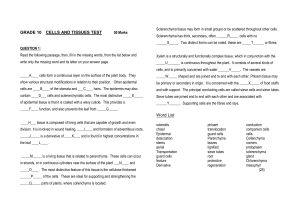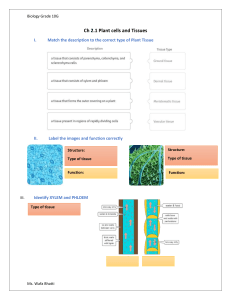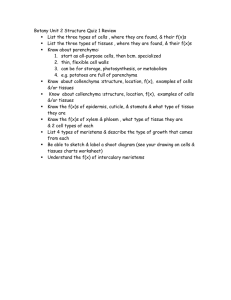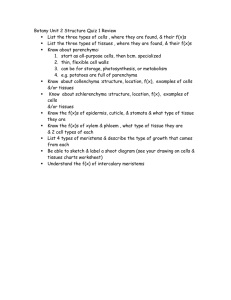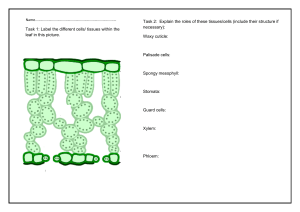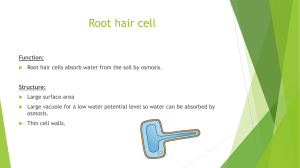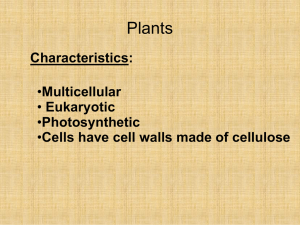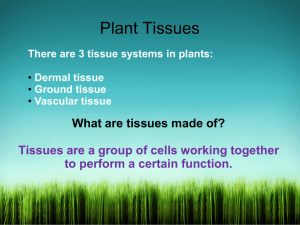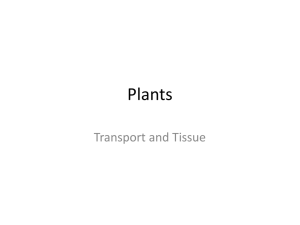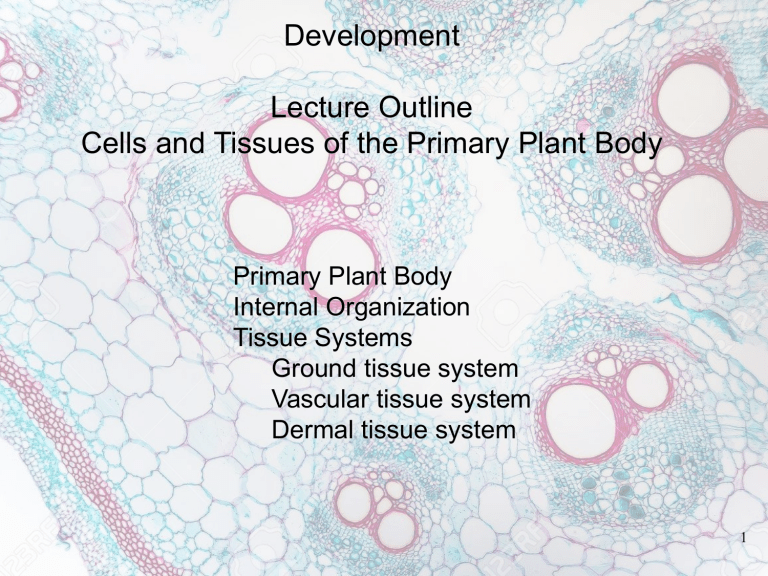
Development Lecture Outline Cells and Tissues of the Primary Plant Body Primary Plant Body Internal Organization Tissue Systems Ground tissue system Vascular tissue system Dermal tissue system 1 The Big Picture Development Cells and tissues 2 Cells and Tissues of Primary Plant Body I. Primary plant body (herbaceous) Primary tissue – tissue differentiated from primary meristems and ultimately from apical meristems, herbaceous 3 II. Internal Organization of Primary Plant Body A. Cells – fundamental units of life. B. Tissue – groups of specialized cells with common functions. Simple tissue – tissues comprised of one cell type Complex tissue – tissues comprised of two or more cell types C. Tissue systems – groups of tissue that show continuity throughout plant body. 1. dermal tissue system epidermis (complex) tissue 2. vascular tissue system xylem (complex) tissue phloem (complex) tissue 3. ground tissue system parenchyma (simple) tissue collenchyma (simple) tissue sclerenchyma (simple) tissue D. Organs – Structures composed of different tissues, i.e., root, stem, leaf, flower parts 4 Distribution of tissue systems dependent on plant organ or taxon 4. General patterns: a. Epidermis outermost in all parts d. Leaves -vascular tissue separate strands (network), xylem above phloem -ground tissue photosynthetic, mesophyll -phyll = leaf b. Stem -vascular tissue embedded in ground tissue, forms network of interconnected strands -xylem internal to phloem c. Root -vascular tissue a solid cylinder -xylem internal to phloem -ground tissue only cortex 5 Tissue systems/tissues III. Ground tissue system A. Parenchyma (simple) B. Collenchyma (simple) C. Sclerenchyma (simple) IV. Vascular tissue system A. Xylem (complex) B. Phloem (complex) V. Dermal tissue system A. Epidermis (complex) -chyma = infusion 6 III. Ground Tissues A. Parenchyma tissue (simple tissue) 1. generalized tissue in the plant body -cortex and pith of roots and stem -mesophyll of leaves -flesh of fruits 7 2. parenchyma cells in continuous masses -living at maturity -thin primary walls -maintain ability to divide (cells with primary cell walls) 3. Used for: -wound healing -adventitious structures (structure arising from an unusual place, such as roots from stems or leaves) -photosynthesis -storage -secretion -some involvement in water and solute transport (vascular tissue) 8 -transfer cells involved in movement of solutes over short distances -highly invaginated cell wall (and plasma membrane) -in xylem and phloem of small veins of leaf -reproductive structures: placenta, embryo sac, endosperm -glandular structures: nectaries, salt glands, carnivorous plants 9 -transfer cells -movement of substances between different symplasts (one tissue type to another tissue) symplats1 10 B. Collenchyma tissue (simple tissue) - in strands or cylinders beneath epidermis - stems and petioles (leaf stalks) - bordering veins of leaves 11 4. collenchyma cells -living at maturity -elongated -unevenly thickened, non-lignified primary walls -soft and flexible -flexible (plastic) support for elongating organs 12 C. Sclerenchyma tissue (simple tissue) 1. sclerenchyma cells -in continuous masses or small groups -lack protoplast at maturity (dead) -thick, lignified secondary wall -strengthening and support (elastic) 13 -fibers long, slender in bundles 0.8 to 70 mm Fiber bundle -sclereids varied in shape often branched short single or aggregated seed coats, nut shells, endocarp of stone fruits stone cells of pears 14 IV. Vascular Tissues A. Xylem (complex tissue) 1. principal water conducting tissue 2. nutrient conduction (via water) 3. support 4. food storage 5. several cell types involved B. Phloem (complex tissue) 1. principal food conducting tissue 2. also composed of several cell types 15 5a. tracheary elements – type of sclerenchyma (lignified) - 2 types: vessel elements and tracheids - elongated cells with 2nd walls - lack protoplast at maturity (dead) - pits in wall - lateral movement of water 16 -early formed (proto) xylem has elements with various thickenings in walls annular – rings; weak structurally, good conductance (d,e) helical – spirals (f) scalariform – ladder like (g) reticulate – network (h) circular bordered pits (i); strong structurally, poor conductance -later formed (meta) xylem elements tend to have reticulate to circular bordered pits since cells do not elongate much (all such elements are tracheids) 17 5b. tracheids -only pits -only type of water transport cell in ferns and gymnosperms -considered less specialized than vessel elements -sloping end walls -occur in groups to allow water transport through pit pairs tracheids vessels 18 5c. vessel element -pits and perforation plates simple perforation plate – single large opening scalariform perforation plate – ladder-like bars -principal water conducting cell in angiosperms -derived from tracheids -sloping to nearly horizontal endwalls 19 -occur end to end to form vessels (several centimeters to meters long) -more efficient for water conduction tracheids vessels 20 water) 6. fibers – for support 7. parenchyma – storage (mostly 21 IV. Vascular Tissues A. Xylem (complex tissue) 1. principal water conducting tissue 2. nutrient conduction (via water) 3. support 4. food storage 5. several cell types involved B. Phloem (complex tissue) 1. principal food conducting tissue 2. also composed of several cell types 22 3a. sieve elements -2 types: sieve cells and sieve-tube elements -have clusters of pores – sieve areas -cytoplasma pass through sieve areas -living cells -newly formed cell, lose nucleus, vacuole, ribosomes, golgi, cytoskeleton -remaining portion of cytoplasm along inside wall with ER, plastids, mitochondria sieve cells sieve-tube elements 23 3b. sieve cells -long narrow cells with sloping end walls -pores narrow, sieve areas concentrated on overlapping ends of cells but found over most of cell -less specialized cell -food conducting in gymnosperms, ferns -associated with albuminous cells – specialized parenchyma cell, supports sieve cell function 24 3c. sieve tube elements -long, broader cells with nearly horizontal end walls -sieve areas on end walls have larger pores, make sieve plate -sieve areas on other walls with narrow pores -occur end to end to form sieve tubes -considered specialized -food conducting in angiosperms 25 -associated with companion cells – specialized parenchyma cell derived from same mother cell as sieve tube element share many cytoplasmic connections aids in function of sieve tube element 4. fibers – strength 5. parenchyma – storage 26 V. Dermal Tissue - Epidermis (complex tissue) 1. outermost layer of cells of primary plant body 2. mostly consists of unspecialized cells without chloroplasts 3. support the cuticle 27 3. other types a. guard cells – control opening of pore (guard cell + pore = stoma or stomate) contain chloroplasts associated with subsidiary cells (reservoir of water for guard cells) 28 b. trichomes – cells with appendages root hairs – absorption of water leaves/stems – reduce air movement or light secretion = glands herbivore defense (mechanical and chemical) glands root hairs 29 4. all cells covered by cuticle on surface 30
